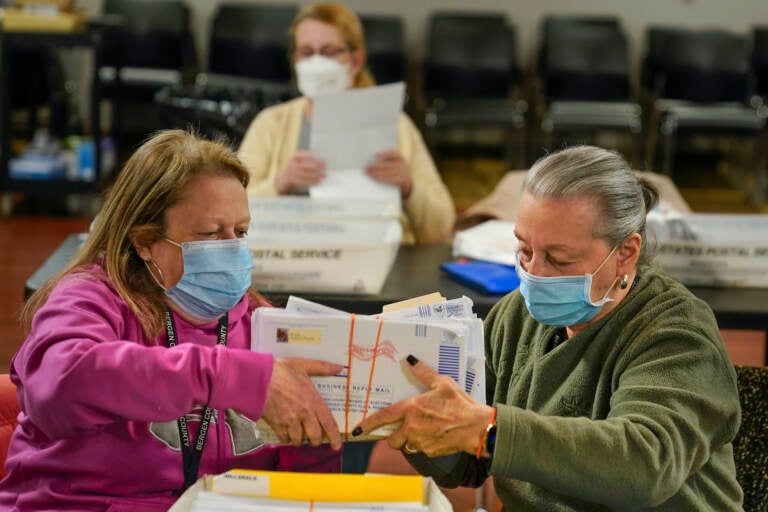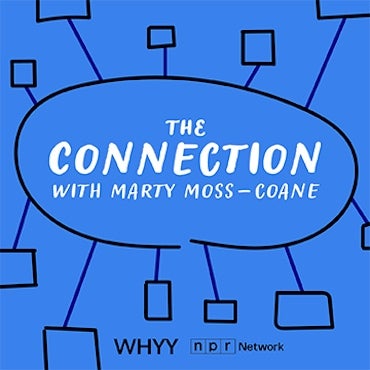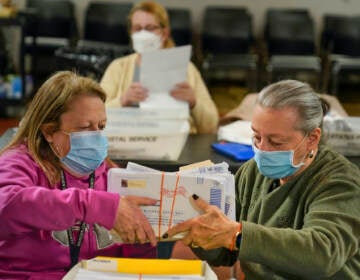No fraud behind late-night votes in N.J. county
Social media users began incorrectly claiming that real-time election results from news organizations showed proof of election fraud in the state’s most populous county.

Board workers Bernadette Witt (left) and JoAnn Bartlett process mail ballots for Bergen County in Hackensack, N.J., Wednesday, Nov. 3, 2021. (AP Photo/Seth Wenig)
As results in New Jersey’s tight gubernatorial race streamed in following Tuesday’s election, social media users began incorrectly claiming that real-time election results from news organizations showed proof of election fraud in the state’s most populous county.
In reality, the posts misunderstood real-time election reporting labels used in Associated Press election data and jumped to false conclusions about the count in Bergen County. Specifically, they zeroed in on a label on those results that said that 100% of precincts had reported, without understanding that the percentage did not include mail-in ballots.
Even after incumbent Democratic Gov. Phil Murphy had eked out a statewide victory against Republican challenger Jack Ciattarelli Wednesday evening, baseless claims that Democrats had nefariously infused ballots into the race in the dead of night continued to spread online by the thousands.
Here’s a closer look at the facts.
CLAIM: Online election results featured on news websites show that around midnight after the New Jersey gubernatorial election, Ciattarelli had won Bergen County with 100% of precincts reporting. By morning, Murphy had somehow taken the lead and more than 41,000 total additional votes had been added, suggesting potential fraud.
THE FACTS: The results don’t indicate fraud. Though 100% of precincts had reported their results from in-person voting by late evening Tuesday, those precinct-level results didn’t include Bergen County’s mail-in ballots, according to a spokesperson at the AP, whose data was used for live election results on various news websites. More than 41,000 mail-in ballots were added to the count early Wednesday morning, explaining Murphy’s pre-dawn boost.
Screenshots displaying election maps and tables from news organizations began spreading across social media on Wednesday morning, with users insisting the images showed proof of wrongdoing.
“At midnight Bergen County (the biggest county) was 100% reported… and red,” said a text overlay on one widely circulating screenshot from an Instagram story. “By 7:30 a.m. they ‘found’ more votes and it flipped to blue?!?!”
“Forensically Audit New Jersey,” read a tweet shared thousands of times. “Something smells in Bergen County.”
Despite the confusion, there is a simple explanation, according to AP spokesperson Lauren Easton: 100% of precincts reporting does not mean 100% of all ballots have been counted.
“For example, in New Jersey, mail ballots are not typically included with the results from individual precincts, but are instead tabulated by the county and added to the results separately,” Easton said in an email. “Bergen County had advised before Election Day that it had received more than 42,000 mail ballots. When the county reported most of those votes early Wednesday morning, AP added them to its tally.”
“Precincts reporting is generally an accurate measure of progress for in-person voting at precincts on Election Day, but in many cases does not account for early or mail ballots,” Easton said. “In some cases, a precinct may report its vote in multiple steps over the course of election night.”
Bergen County Elections Division Supervisor Sabrina Taranto confirmed that 100% of precincts reporting does not mean all ballots have been counted. Instead, she told the AP in an email, it means that “70 of the 70 towns in Bergen County’s election day machine vote were received and counted.”
“These totals do not reflect any other type of vote such as Vote by Mails, Provisionals, Early Voting, etc,” Taranto wrote. “This is the standard method followed by our office for every election.”
AP called the governor’s race for Murphy on Wednesday evening when a batch of votes from Republican-leaning Monmouth County increased Murphy’s lead and made a Ciattarelli win impossible.

Get daily updates from WHYY News!
WHYY is your source for fact-based, in-depth journalism and information. As a nonprofit organization, we rely on financial support from readers like you. Please give today.






